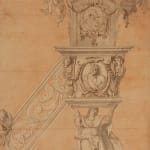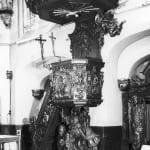Open a larger version of the following image in a popup:


Pieter II Verbruggen, Pulpit for the Cloister of the White Friars, Antwerp.
Pieter II Verbruggen (Antwerp 1648 - 1691)
Design for the Pulpit of the Cloister of the White Friars, Antwerp
pen and brush in brown, sanguine on laid paper
370 x 265 mm
Pieter II 'the Younger' Verbruggen was born in Antwerp in 1648. His father, Pieter I 'the Elder', was one of the leading sculptors in Antwerp; his mother, Cornelia Quellinus, was...
Pieter II 'the Younger' Verbruggen was born in Antwerp in 1648. His father, Pieter I 'the Elder', was one of the leading sculptors in Antwerp; his mother, Cornelia Quellinus, was the daughter of Erasmus I Quellinus, who had taught Pieter I. Pieter II was most likely taught by his father; in 1660/1 he was admitted into the Antwerp Guild of St Luke as a 'winemaster' (son of a master). After his admittance into the guild he worked in his father's workshop. On the 8 of September 1674 he travelled to Rome accompanied by several others, including the painters Abraham Genoels and François Moens. Travelling via Germany and Austria, the company arrived in Rome on 4 November 1674. There he studied the local architecture and made drawings after Bernini and antique sculpture. In 1675 he joined the Bentvueghels (a Roman society of Northern artists); his bentnaam (nickname) was Ballon (Balloon). In 1677 Pieter II returned to Antwerp; he married Maria Isabelle Heck in 1688 and became dean of the Guild of St Luke in 1691. Later that year he died and was buried in St. Andries Church, on 12 October 1691.
Pieter II Verbruggen was a skilled draughtsman and printmaker as well as a talented sculptor. He worked alongside his father on the main altar of the Antwerp Church of St Paul (the design for which he engraved in 1670) and worked on a contract for the Antwerp Church of St Andrew with Lodewijk Willemsens. He also executed several terracotta busts depicting members of the Moretus family, which today are still kept in the Museum Plantin-Moretus. The present sheet is a preparatory drawing for the pulpit Verbruggen made for the Chapel of the Cloister of the White Friars in Antwerp (nowadays known as the Keizerskapel; see ill.). Interestingly, another drawing for the project by Verbruggen - which shows some differences from our drawing, as it adheres closer to the finished pulpit in several details - has also survived, and is today kept in the Rijksmuseum (inv. no. RP-T-1987-34.)
Provenance
Charles Gasc, Paris (L.543);
Private collection, France.


